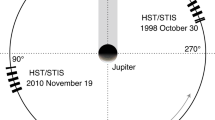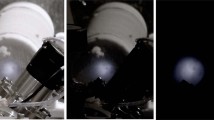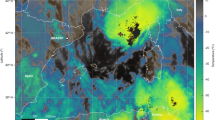Abstract
Photographs taken on early space shuttle flights have indicated the presence of a surface glow in the ram direction1. Examination of airglow data from the AE and DE satellites has shown, the presence of a similar glow2, suggesting that the phenomenon is general to spacecraft in low Earth orbit, with the emission being concentrated in the ram direction. Several explanations have been offered for the glow: (1) OH formed by surface reactions of fast 0 atoms3; (2) plasma discharge mechanism4; (3) surface-induced decomposition of N2 followed by recombination into an excited state5; (4) surface emission by impact of O2 and O (ref. 6); and (5) near-continuum emission (at a resolution of ∼3.4 nm) in the region 400–800 nm from electronically excited NO2 (ref. 7). With reference to the last hypothesis we discuss here data on the number density of NO2 measured inside the payload bay of the shuttle orbiter. We also derive fluxes of NO2 near shuttle surfaces. Our data are shown to be consistent with the hypothesis of the glow being caused by NO2 emission.
This is a preview of subscription content, access via your institution
Access options
Subscribe to this journal
Receive 51 print issues and online access
$199.00 per year
only $3.90 per issue
Buy this article
- Purchase on Springer Link
- Instant access to full article PDF
Prices may be subject to local taxes which are calculated during checkout
Similar content being viewed by others
References
Aviat. Week Space Tech. 116, 19, 14 (1982).
Yee, J. H. & Abreu, V. J. Geophys. Res. Lett. 10, 126–129 (1983).
Slanger, T. G. Geophys. Res. Lett. 10, 130–132 (1983).
Papadopoulos, K. Radio Sci. 19, 571–577 (1984).
Green, B. D. Geophys. Res. Lett. 11, 576–579 (1984).
Prince, R. H. Geophys. Res. Lett. 12, 453–456 (1985).
Swenson, G. R., Mende, S. B. & Clifton, K. S. Geophys. Res. Lett. 12, 97–100 (1985).
Wulf, E. & von Zahn, U. . J. geophys. Res. 91, 3270–3278 (1986).
Stephan, K., Helm, H., Kim, Y. B., Seykora, G., Ramler, J. & Grössl, M. J. chem. Phys. 73, 303–308 (1980).
Märk, T. D. & Hille, E. J. chem. Phys. 69, 2492–2496 (1978).
Yee, J. H. & Dalgarno, A. in Proc. AIAA Meet. Shuttle Environment and Operations, Washington (1982).
Schwartz, S. E. & Johnston, H. S. J. chem. Phys. 51, 1286–1302 (1969).
Mende, S. B. et al. J. Space Rock. 23, 189–193 (1986).
Korb, L. J., Morant, C. A., Calland, R. M. & Thatcher, C. S. Bull. Am. ceram. Soc. 60, 1188–1193 (1981).
NASA Handbook, Space Shuttle System Payload Accommodations Vol. XIV (Rev. HJSC-07700, 1983).
Engebretson, M. J. & Mauersberger, K. J. geophys. Res. 84, 839–844 (1979).
Glasser, R. P. H. An Introduction to Chemisorption and Catalysis by Metals 190–197 (Oxford University Press, New York, 1985).
Kofsky, I. & Barrett, J. L. Planet. Space Sci. (in the press).
Tully, J. C. J. Chem. Phys. 73, 6333–6342 (1980).
Köhnlein, W. Planet. Space Sci. 28, 225–243 (1980).
Author information
Authors and Affiliations
Rights and permissions
About this article
Cite this article
Zahn, U., Murad, E. Nitrogen dioxide emitted from space shuttle surfaces and shuttle glow. Nature 321, 147–148 (1986). https://doi.org/10.1038/321147a0
Received:
Accepted:
Issue Date:
DOI: https://doi.org/10.1038/321147a0
This article is cited by
-
Origin of the shuttle glow
Nature (1991)
-
Atmospheric and glow images from the Shuttle
Surveys in Geophysics (1987)
Comments
By submitting a comment you agree to abide by our Terms and Community Guidelines. If you find something abusive or that does not comply with our terms or guidelines please flag it as inappropriate.



